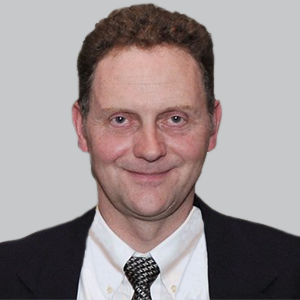Article
Cure Rare Disease Seeks to Lead Innovation in Rare Disease Treatment
Author(s):
The president and founder of Cure Rare Disease discussed the company’s custom therapeutics for patients with rare diseases, including the use of CRISPR gene-editing technology to develop treatments for Duchenne muscular dystrophy.
Rich Horgan, MBA

Cure Rare Disease (CRD) is working to revolutionize the pharmaceutical space for rare diseases, namely Duchenne muscular dystrophy (DMD).
Rich Horgan, MBA, founder and president, CRD, started the biotech nonprofit with the primary goal to save his brother Terry, a 24-year-old man who has been battling DMD for the past 2 decades. The organization has been at the forefront of developing customized therapeutics, including using revolutionary CRISPR gene-editing technology to treat rare disease.
In collaboration with a group of highly skilled researchers, geneticists, and clinicians, the company recently launched its first humanized mice/dosing trial for their novel treatment with hopes that the FDA will greenlight administration in humans later in 2020.
Horgan sat down with NeurologyLive® to outline how the company is trailblazing the way for new treatments in patients with DMD, as well as detailing the greatest need within the community at the moment.
Click here for more information on Cure Rare Disease and its resources.
NeurologyLive®: What is Cure Rare Disease?
Rich Horgan, MBA: Cure Rare Disease is a nonprofit, biotech located in Boston, Massachusetts. We're developing customized therapeutics for rare genetic diseases through a collaboration with several academic and for-profit institutions. We started back in late 2016. Inspired by Dr. Tim Yu of Boston Children's Hospital, we had the idea to understand the patient at a molecular genetic level if we're going to develop a customer therapeutic for them. The first patient was my 24-year-old brother, Terry. He suffers from a rare mutation of Duchenne. Since Terry is an older patient and non-ambulatory, he's excluded from the majority, if not all, clinical trials currently under development by for-profit companies.
We started this effort as a way to develop a technology that could act as a proof-of-concept by safe comparator and hope to encourage the development of broad ecosystem. In this ecosystem, single-patient drug development, or bespoke therapeutic development, can have a place in the larger scheme of development, so that even a patient that's 1 of a kind can also seek benefits through the development of customer therapeutics. Not only working with researchers and clinicians, but it's also working with regulatory agencies, and also payers, so that we can enable an ecosystem whereby larger companies, for-profit companies, and clinical investigators at academic institutions can develop single-patient drugs. How do we we get the regulatory agencies to issue guidelines that support the second part of development? This is something that’s on the forefront of the FDA’s mind. How do we work with payers or insurance companies to support, through reimbursement, that type of drug development? Not from the research aspect, but how do we how do we get payers to support the reimbursement of hospitalization charges and, and hopefully someday how do we get payers to support other non-research costs?
How does Cure Rare Disease use precision medicine and CRISPR technology to develop therapies for Duchenne muscular dystrophy?
We start with first characterizing and identifying the specific mutations. In Terry's case, in late 2018, we took a muscle biopsy that allowed us to understand what was going on at a molecular and genetic level. Is he producing transcript? Is he producing protein? And where's the mutation? What's the size of mutation? We thought to ourselves, “What therapeutic strategy could we potentially employ to remediate the condition?” That first step of really characterizing the patient is essential because if we're going to develop something that's super specific, we need to make sure we're getting the right target.
After the bioinformatics analysis, we started to test the strategies that have been theorized at Yale using a CRISPR activation approach to upregulate an alternative form of the gene. With Terry—and we did this because of the results from the bioinformatics—results showed that Terry was producing trace levels of dystrophin, which we surmised to be the alternative form, the cortical isoform, and so we said “Is the body sort of compensating by trickling this dystrophin into skeletal muscle? Could we really use CRISPR to upregulate and activate that isoform and take the drip into a much steadier stream of dystrophin being produced by the body using CRISPR activation?”
After showing the in-vitro proof-of-concept and proof-of-principle, we're starting to figure out how much do we give to a patient because we only get 1 shot at this. It's extremely critical to get the right dose and it’s also really difficult because, being a first-event therapeutic, we're not sure what the right dose is. That's what we're figuring out in our preclinical studies with mice. We’re using a humanized Duchenne mouse model because we have human specific therapy with humanized RNA, so therefore, we need to test it on something that has a humanized dystrophin gene. Through these studies, we're figuring out how much do we give and then, consequently, we'll figure out what the safety profile and finalized dose are. This will be done later in 2020, before we, in parallel, get the FDA’s approval to administer the therapeutic.
What is the current treatment landscape for DMD and where is the greatest need?
What we're seeing now is really the early days of high impact treatments for Duchenne muscular dystrophy. For a while, we’ve seen mostly symptom management type of approaches with corticosteroids and supplements, which is not super effective, but of course is better than nothing. Now, we're starting to see the likes of the next-generation therapeutics with Sarepta, Vertex, Solid, and Pfizer. They are creating gene replacement strategies, which is taking the dystrophin gene, which is too large to fit into an AAV, and chopping it up into smaller pieces that they think are critical, and then packaging as much as they can into an AAV and deploying it within the body.
That's just taking a smaller form of the dystrophin gene and getting it in the body. Something is better than nothing, but the impact is still unclear at the moment. The big takeaway is that more is needed. A lot of the drug development has been focused on hotspot regions, in exon 53 and exon 51. These areas are the most common and have the most patients with more common genetic mutations for Duchenne. The challenging part has been older patients and non-ambulatory patients who have put in the most time who aren't seeing the benefits from this. This could be because clinical trials have tighter enrollment criteria, or because they have a very rare mutation that isn't really economically viable for drug development. At Cure Rare Disease, we're trying to develop drugs and therapeutics that are for the rarer mutations within Duchenne and also those that have been overlooked. What we're trying to do is be another tool for patients that have no treatment or no hope of the treatment.
What impact can advocacy groups have on clinical drug development?
I think advocacy is useful. The role that advocates play in this is helping drug developers to understand what is important to a patient. At the end of day, you might sit back and say, well, that's kind of obvious. There's no silver bullet in drug development, for the most part, but helping drug developers understand what the patient's value and what the patient is looking for in treatment is critical. If you ask my brother what he values the most, his answer probably wouldn't be, “Can I walk around,” his answer would be “full mobility of the hands and upper body.” That's good to know. Hitting a home run as a drug developer is great, but it’s riskier. Whereas if we can target things to fix what's really bothering the patient, we can make sure that the endpoint in clinical trials are properly geared for what a patient would expect.
The industry has suffered through that double-edged sword with the 6-minute walk test. The 6-minute process is great if you can walk, but if you’re among the significant percentage of the Duchenne population that can’t walk, you're automatically excluded from the trial. How can we use advocacy to help paint new endpoints that are clinically meaningful and eventually validated to be incorporated in clinical trials to get more participation? One clinical trial was shut down a few weeks ago because it couldn't be enrollment. That is a concern because if drug developers as a whole are trying to pull from the same population, say the exon 53 population, it's going to be really tough to get clinical trial enrollment because you're pulling from a population that accounts for only 11% to 13% of a rare disease. You have to you have to start pulling from a broader set of the population.
I think it's up to advocacy groups to help the industry understand how we can develop new endpoints that are better and more meaningful than a 6-minute walk. Additionally, how can we work with the industry to make sure that more patients are included with clinical trials? It’s unfair to not allow patients who are who are older, or non-ambulatory, or who cannot even get access to a clinical trial because of their situation, when in fact, they put in the most time.
What are the next steps for CRD in terms of drug development, and where do you see it going?
In the short term, we're trying to show that this idea of customer therapeutics using CRISPR can work. Our definition of can work is getting our first and second and third patients dosed with an effective CRISPR treatment therapeutic. For my brother in the next year or so, we intend to dose him with this and, hopefully, save his life.
Behind Terry, we've got what we're calling “cohort zero,” which is a group of 5 boys who all have different mutations, rare mutations, and are in different parts of their journey. What we want to do after dosing Terry as a proof-of-concept, is then move into a larger cohort or cohort zero, where we can really show more proof-of-concept and ultimately take these data points—assuming success—to insurance companies encourage the reimbursement of pieces of this cost. Not all the cost because it wouldn't be fair to put all the costs on 1 group, but to support the beginning of reimbursement for customized therapeutics. We're the only ones doing this on that scale and really using CRISPR to target more broad rare diseases and to really create an ecosystem.
Overall, the short-term includes dosing Terry, developing therapies for cohort zero, implementing the scaling that we think can work in this area, and then figuring out how we can make this scaling for more than just this group. Eventually, we want to get the support of insurance for input and then the supportive guidelines from the FDA actually go through with this drug development.
We know we need the support of the community. We're a grassroots organization. We aren't huge, we're quite young. But our partners that we've developed across industry are hugely supportive. Even for a patient, in a place like Nebraska, who, say, has no interest in science, we’ve created an ecosystem where a patient with little knowledge of science can connect with a clinician who has the initiative to take it upon themselves to develop something for which we create an ecosystem. While we won't and don't intend to develop drugs, for every single patient in the world, what we're trying to do is develop a drug for a significant part of a group and enable an ecosystem so that others can come into the fray too. To do that we need support from all sorts of different organizations and all sorts of different partners.
Is there anything else that stands out about the organization?
If this was some sort of Venn diagram and the left circle was for-profit drug development and the right circle was patient advocacy, we're somewhere in the middle. We're the third part of the circle that connects the 2 because we're doing drug development through our collaborators. We've collected a group of researchers and clinicians who see the vision, who have passion for it, and are trying to do something different. Drug development as a whole has been a struggle over the past several decades. That's a really long time. If you're a patient that's born with a fatal and progressive disease today, you're at significant risk to not have the industry do what they do best.
At CRD, we’re trying to introduce a new perspective by bringing the best minds together, helping to fund them, and then pointing them in the same direction. That new methodology of true open collaboration is something I think the industry hasn't been seen yet. It’s that transition between discovery to preclinical to eventually the patient’s bedside, and bringing these groups all together from the beginning helps speed up a patient treatment. This is drug development that's highly focused, highly translational, and is efficient at the same time. That makes a big difference. When people are ready to donate, they want to know what they are getting for their donation. Where is it going? We as an organization put as much money as humanly possible into the research. At the end of the day, we’re trying to develop drugs for patients who have been waiting for them since yesterday.





